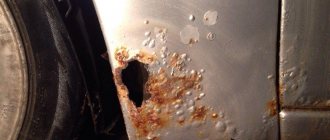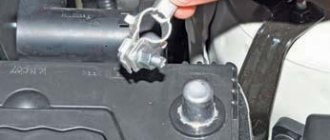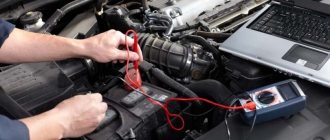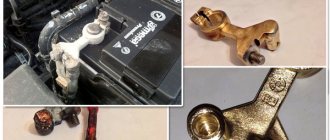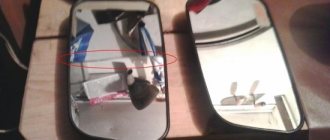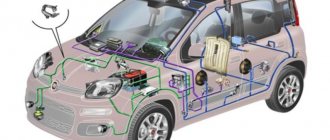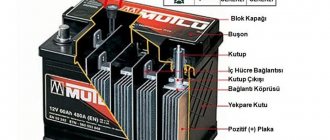How to repair a cracked battery yourself
A hole—a crack in the battery case—is a very negative thing: the electrolyte leaks out, corroding everything in its path, and the power inside the battery drops.
In general, everything is bad: you need to go and buy a new battery. But here comes another moment of truth: what if there is no money?! Then you need to repair the crack in the battery! How? Read below and find out everything. By the way, if you don’t want to bother with repairs, I recommend purchasing a new battery here https://magazun.com/akkumulyatori/. Firstly, if you discover that the battery case is depressurized, you should immediately remove it. But this should be done very carefully, since acid, which easily corrodes metal, will eat your hands without remorse (the author tested it on himself: it really hurts). Therefore, be sure to wear thick rubber gloves, a respirator and goggles: this will protect you from acid. And don't ignore the advice! Acid is like oil in a frying pan: you don’t know exactly how it will behave in a second! After removing the battery from the car, place it on the floor and leave it for now: you should start removing the effects of an acid attack! The acid that is spilled inside the hood remains a very aggressive substance: you can’t wipe it off with a rag. First you need to neutralize the effect of the acid. We remember from the chemistry course that alkali serves as a neutralizer for acids. Where can I get lye? Gentlemen: yes, it is in every home - it’s baking soda. Just sprinkle baking soda on the acidic areas and wait a few minutes.
Then take a scoop and remove the neutralized acid. Now we return to the battery again. Lay it on its side and, with some sharp object, lightly scratch the path of the crack. This measure is necessary in order to create adhesion for the substance that will serve as a patch on the battery case. Degrease the treated surface with some solvent or acetone and wipe dry with a rag. Now we move on to making the patch mixture. Take epoxy glue and mix it with some of the sawdust that you sawed when cleaning the crack with a sharp object (knife, nail, etc.).
The resulting mixture will perfectly close the crack in the battery case. The main thing: evenly distribute the glue with sawdust over the surface of the crack. The patch mixture dries within an hour. Also. as an alternative. You can use a regular soldering iron: move the hot soldering iron along the crack, directing the melting plastic inside the battery.
In general, the soldering iron is easy to understand. Attention: before you begin repairing the housing, all electrolyte must be drained from it. And after the repair is completed, the battery should be filled with new electrolyte and charged. But if you don’t want to repair the old battery, but buy a new one, then you need to select the battery according to its size so that you don’t have to make an extra trip to the store.
Another problem that sometimes occurs with batteries is a broken positive terminal. Of course, the solution to such a problem would seem to be within the capabilities of only service station technicians: welding is indispensable. But this is only at first glance. Take a drill and a bit. Drill a hole through both terminal elements to be fastened together. Hole diameter 4 mm.
Now take a conductive lubricant and treat the joining surfaces of the elements. This way you will reduce the resistance of the joint and protect it from the oxidative process. And then you can fasten the split contact (terminal) with a regular self-tapping screw! In general, during the restoration process you will understand everything yourself: if you have the desire.
Repairing car battery case cracks
“How to seal a crack in a car battery case?”
Battery cases are made from plastics: polyethylene or polypropylene. Housings for budget batteries are made from the first, and for premium ones from the second.
Polypropylene is less dense than polyethylene, harder, has better abrasion resistance, is more heat-resistant (begins to soften at 140°C, melting point 175°C), and is almost not subject to corrosion cracking.
Both materials are chemical resistant. Concentrated sulfuric acid at room temperature has little effect on them. But prolonged contact with it at 60 °C and above leads to the destruction of polypropylene and polyethylene. It is also undesirable for gasoline to come into contact with the heated battery housing. At high temperatures, aromatic hydrocarbons (gasoline) dissolve the materials in the battery casing.
In some brands of cars, the battery is located in the trunk or interior. This is the best solution for preserving the battery case. In second place in terms of safety are special boxes that protect the battery under the hood. In addition to protective functions, some boxes feature a supply of hot air from the heating system. In winter, such a battery is heated, which makes it possible to better preserve it.
In modern cars, the temperature under the hood in summer reaches 90°C. Usually, for batteries located next to the engine, the bank closest to the engine fails (boils out, overheats). The best way out in this situation is to put a protective casing on the battery, adding to it an improvement in the form of heat-reflecting material. It can be made from the most ordinary solar reflector under the windshield.
How to seal the battery
How to seal the battery. (the hole is about 5x15 mm) I tried this, it fell off
its body is made of such cool plastic that it is impossible to seal it (and even acid). If the hole is below the waterline, then change the battery.
The fact of the matter is that it’s higher, the top edge (corner). On the bumps it little by little splashes out anywhere(
you need to make something like a clamp around the entire case, close the hole itself with a thick rubber band that will be pressed like a rectangular ring around the entire battery
The battery case is usually made of impact-resistant, heat-resistant propylene or polypropylene.
I sealed mine with cold welding and nothing fell off. Both winter and summer have passed. Try a different weld.
I soldered it on the shistik and kept it. A really big soldering iron, which is used to tin radiators.
How can you seal a car battery?
The battery in a car can be damaged for various reasons, for example, during an accident, during removal or installation. Regardless of the cause of the crack, you can fix it yourself without turning to specialists.
A crack in the case is a nuisance, the cause of which is most often the battery. If acid leaks from it, it must be stopped immediately and subsequent leakage must be prevented. To remove acid without any consequences, you need to neutralize the acid by mixing it with alkali. For example, you can use baking soda. If the acid has spilled just a little, then you just need to remove it with water and a solution of thickly diluted soda.
When washing such a small stain, you must protect your hands with thick rubber gloves. But if the acid has spilled abundantly and has already formed a puddle, then the next course of action depends on the location of the leak. If a large amount of acid is spilled in a residential area, you need to call a special service that will neutralize the acid. If this happened on the street or in the garage, then you can solve this issue yourself. You can neutralize acid in large quantities using a solution with soda with the highest possible concentration of soda. After this, fill it with sand, mix it and put it away.
Once you have dealt with the acid problem, you need to start sealing the battery. To do this, you need to make a small furrow at the crack site. This furrow must be degreased with acetone or solvent. Then prepare a mixture of sawdust after creating the furrow and suitable glue to fill the crack.
In addition to this method, you can use the soldering method. To do this, you need to use a regular soldering iron, which can be easily found in almost every home. In addition to the soldering iron, you need to use a small piece of polyethylene. No matter how dirty the soldering iron gets, you can make an attachment from improvised materials, it will protect the tip. You can make such a nozzle, for example, from a tin can. The main thing is to wash it well, no matter if there are any fats or food residues on the jar. If you cannot do something yourself, it is better to turn to specialists.
Battery Battery acid Sealing the battery
whatican.ru
Advertisements on NN.RU - Auto
Manufacturing of a broken-type platform with retractable ramps on the GAZ-33023 Gazelle-farmer chassis. Technical characteristics of the tow truck.
Lengthen Gas 331043, 331063 Valdai-farmer for installation of a body 5.1/6.5 m. The chassis is lengthened by increasing the wheel size.
A specialized company for the conversion of trucks produces extensions for man man, iveco and iveco truck tractors.
Lengthen Kamaz under a body 7.5 m Lengthen Maz Zubrenok, Maz under a body 9 m Re-equipment of the chassis of an extended truck.
Cracked battery, how to seal it
“How to seal a crack in a car battery case?”
Battery cases are made from plastics: polyethylene or polypropylene. Housings for budget batteries are made from the first, and for premium ones from the second.
Polypropylene is less dense than polyethylene, harder, has better abrasion resistance, is more heat-resistant (begins to soften at 140°C, melting point 175°C), and is almost not subject to corrosion cracking.
Both materials are chemical resistant. Concentrated sulfuric acid at room temperature has little effect on them. But prolonged contact with it at 60 °C and above leads to the destruction of polypropylene and polyethylene. It is also undesirable for gasoline to come into contact with the heated battery housing. At high temperatures, aromatic hydrocarbons (gasoline) dissolve the materials in the battery casing.
In some brands of cars, the battery is located in the trunk or interior. This is the best solution for preserving the battery case. In second place in terms of safety are special boxes that protect the battery under the hood. In addition to protective functions, some boxes feature a supply of hot air from the heating system. In winter, such a battery is heated, which makes it possible to better preserve it.
In modern cars, the temperature under the hood in summer reaches 90°C. Usually, for batteries located next to the engine, the bank closest to the engine fails (boils out, overheats). The best way out in this situation is to put a protective casing on the battery, adding to it an improvement in the form of heat-reflecting material. It can be made from the most ordinary solar reflector under the windshield.
Repairing cracks in the battery case can be done by gluing, welding or soldering. You need to solder the plastic of the battery case with the same material from which it is made. A piece of the dust protection strip of the same battery, which covers the dust plugs, will work well for the patch.
It is imperative to prepare the surfaces that will be joined. This is done using sandpaper. Next, remove any fatty residues. For this purpose alcohol is used. Degreasing is a necessary procedure when welding or gluing elements: the results will be much better and the patch will last longer.
The soldering process can be carried out using a regular soldering iron or a special hair dryer gun for gluing plastic.
Fix the patch using glue for polypropylene or using cold welding for plastic according to the instructions for them. Only special types of adhesives can properly glue polypropylene and polyethylene. Soldering method is preferable. Fixing a patch glued with glue or cold welding is done using electrical tape wrapped around the battery body, which will compress the glued elements for one hour.
